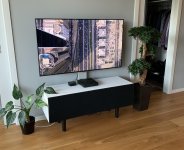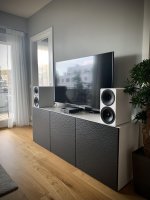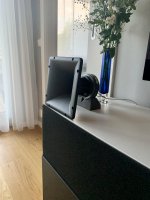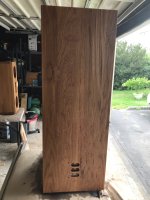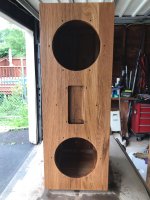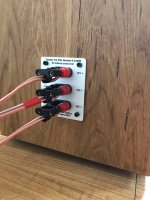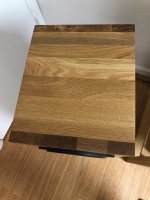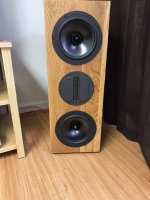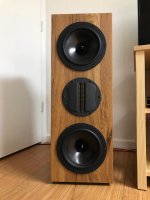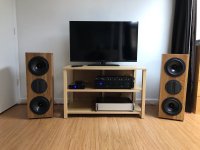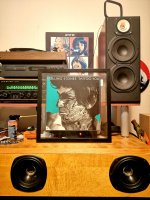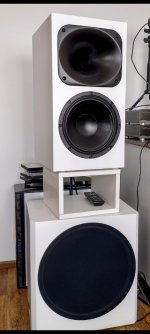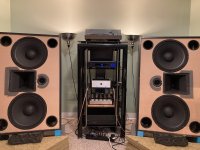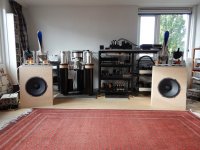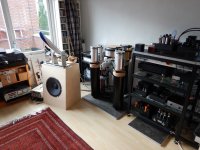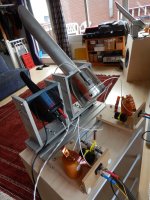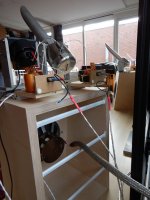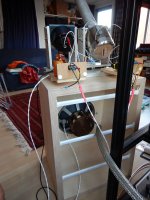Hi Daniboun,
Wich speakers are used, last one seem to be an Audax
BR,
Pascal
That s right ) Triangle for the Mediums and Audax for bass.
it is a 2.5 Way with "filtrage en l'air" and Ribbon tweeters.
Just built these MTM boxes with two Dayton RS-225-8 mid/woofers and a Hi-Vi RT2C-A planar tweeter. This project was a bit of an experiment both electrically and in materials with the cabinets being made from 1” thick laminated white oak boards. The solid oak is certainly harder to work with than plywood or MDF but it does have its advantages, like no thin veneer or hidden voids to worry about. I just wanted a very rigid cabinet without having to use internal cross bracing or multiple layers. These boards, which are sold as stair treads, are made from 3-6 pieces of oak laminated in alternating grain directions for stability and this also makes for some very diverse and interesting grain patterns. So I opted to highlight this feature in the design by selecting the most “interesting” pieces for the front panels and by using simple butt joints to show off the natural beauty of the end grain rather than trying to hide it with miter joints or edge banding. The result has somewhat of a butcher block appearance and it’s certainly not boring. The design goal of rigidity comes at the expense of weight, 45 lbs each without the drivers and about 60 lbs with everything installed. Finished liberally with Danish oil, inside and out, to seal and protect.
This is a dual sealed cabinet with acoustically isolated chambers for each woofer. The tweeter is essentially surface mounted on the outside of the cabinet so it’s fully isolated from the woofers. Each driver is powered by a dedicated amp channel driven from a two-way, 24 db/octave, active crossover with fc at about 2 kHz. Yes, the woofers are driven from the same low end signal but this signal drives two power amp channels, one for each woofer. The idea here is full acoustical and full electrical isolation for the drivers, until their sound adds together in the room. The reason for the active crossover is to eliminate all passive reactive components between the amp and the driver so it will more accurately convert the amp signal to sound. The reason for the acoustical and electrical isolation is basically the same: to eliminate all other possible sources of interference between drivers and allow each one to perform it’s best. Admittedly, this is probably of lesser concern than eliminating the passive crossover, but it was fairly easy to achieve in the design, so I went for it. After all, it is an experiment.
The rest of the system is currently an 8 channel power amp based on the Apex PA12 power op amp (Chip Amp Photo Gallery post # 3401) and a pre-amp based on the Linear Tech LT1057, both of my design. The active crossover is an ART CX311, which is a great starting point for going active because it’s easy to adjust the crossover frequency and output levels and it also adds a sub-woofer output to the system. I’ve done most of the tuning by starting with the driver data sheets, and then checking the crossover region for flatness with a signal generator and a sound level meter, and finally, with my ears. The speakers do sound good, better than I was expecting. Now it’s time to go through the entire music collection again because it all sounds better than ever.
This is a dual sealed cabinet with acoustically isolated chambers for each woofer. The tweeter is essentially surface mounted on the outside of the cabinet so it’s fully isolated from the woofers. Each driver is powered by a dedicated amp channel driven from a two-way, 24 db/octave, active crossover with fc at about 2 kHz. Yes, the woofers are driven from the same low end signal but this signal drives two power amp channels, one for each woofer. The idea here is full acoustical and full electrical isolation for the drivers, until their sound adds together in the room. The reason for the active crossover is to eliminate all passive reactive components between the amp and the driver so it will more accurately convert the amp signal to sound. The reason for the acoustical and electrical isolation is basically the same: to eliminate all other possible sources of interference between drivers and allow each one to perform it’s best. Admittedly, this is probably of lesser concern than eliminating the passive crossover, but it was fairly easy to achieve in the design, so I went for it. After all, it is an experiment.
The rest of the system is currently an 8 channel power amp based on the Apex PA12 power op amp (Chip Amp Photo Gallery post # 3401) and a pre-amp based on the Linear Tech LT1057, both of my design. The active crossover is an ART CX311, which is a great starting point for going active because it’s easy to adjust the crossover frequency and output levels and it also adds a sub-woofer output to the system. I’ve done most of the tuning by starting with the driver data sheets, and then checking the crossover region for flatness with a signal generator and a sound level meter, and finally, with my ears. The speakers do sound good, better than I was expecting. Now it’s time to go through the entire music collection again because it all sounds better than ever.
Attachments
Hi amigos,
Got my new DACS33 100% made in France with high quality components. The Ribbon tweeter is mounted with a slight hook towards the rear.
The overall balance of these columns is amazing!
The filtering is carried out entirely by hand in accordance with the rules of the art. Thanks to Vincent for his meticulous work!





Got my new DACS33 100% made in France with high quality components. The Ribbon tweeter is mounted with a slight hook towards the rear.
The overall balance of these columns is amazing!
The filtering is carried out entirely by hand in accordance with the rules of the art. Thanks to Vincent for his meticulous work!





Bedroom vintage.
A matching JVC receiver and Dual 506 turntable like my family had when I was a kid, NAD 515 BEE CD player, diy speakers, and a diy repurposed trio of Tannoy DC as soundbar.
Up front , a Rolling Stones Tattoo You promo jacketi haven't seen before, found at a sidewalk sale under glass, finally.
A matching JVC receiver and Dual 506 turntable like my family had when I was a kid, NAD 515 BEE CD player, diy speakers, and a diy repurposed trio of Tannoy DC as soundbar.
Up front , a Rolling Stones Tattoo You promo jacketi haven't seen before, found at a sidewalk sale under glass, finally.
Attachments
The design goal of rigidity comes at the expense of weight, 45 lbs each without the drivers and about 60 lbs with everything installed. Finished liberally with Danish oil, inside and out, to seal and protect.
...
After all, it is an experiment.
The speakers do sound good, better than I was expecting. Now it’s time to go through the entire music collection again because it all sounds better than ever.
It sounds like the experiment was a success !!!
Lookin' good too.
Thanks....
Thanks for your comments Pilover2000. It took a while to get the crossovers dialed in and REW was a great help there. So yes, I would call the experiment a success. Now the plan is to build a couple of subs (from the same boards) - that's what the other two amp channels are for. Thanks again.
Thanks for your comments Pilover2000. It took a while to get the crossovers dialed in and REW was a great help there. So yes, I would call the experiment a success. Now the plan is to build a couple of subs (from the same boards) - that's what the other two amp channels are for. Thanks again.
second set
How did you paint those flat black? They came out perfect
How did you paint those flat black? They came out perfect
That's not my fault
I take them to a professional painter that paints kitchen furniture for living
where exactly the nude lies in the signal chain?
Sorry for the delay. I don't understand what you mean by nude in the signal chain. Is nude a misprint?
My first time image posting on a forum, I tried to add a description after posting the images but it wouldn't let me for some reason!
My Lxmini (temporarily placed while I recover from foot surgery, I'll tidy it up as soon as I can walk again) with 2x ncore powers and the N Pass designed crossover. I love these speakers and they are simply just enjoyable to listen to. The centre image (vocals especially) seem to spread out from them, filling the room. They seem to excel with live recordings and really love playing live jazz.
I built the troels sba10 a while back. They sound phenomenal (following a dirac intervention due to my room) vocals sound real to me and the imaging is to die for. I suspect with a bigger room They would sound better still. They (clearly) aren't finished yet.
I love the troels so much I'm considering paying for someone to build professional looking cabinets for them.
My Lxmini (temporarily placed while I recover from foot surgery, I'll tidy it up as soon as I can walk again) with 2x ncore powers and the N Pass designed crossover. I love these speakers and they are simply just enjoyable to listen to. The centre image (vocals especially) seem to spread out from them, filling the room. They seem to excel with live recordings and really love playing live jazz.
I built the troels sba10 a while back. They sound phenomenal (following a dirac intervention due to my room) vocals sound real to me and the imaging is to die for. I suspect with a bigger room They would sound better still. They (clearly) aren't finished yet.
I love the troels so much I'm considering paying for someone to build professional looking cabinets for them.
I have built a 2-way sealed box active speaker using Eighteen sound 10NMB420 and NSD1095N with XT1086 horn and Hypex FusionAmp FA123. The drivers are 16 Ohm versions and the box is made by professional carpenter. The build is based on a Ruutinassakka (gunpowder pouch), but I made it active, thus I named it Aktiivinassakka (active pouch). I could post full build description and details if anyone wants to read it, but I think the world is full of 10" + horn-CD already  I'm using miniDSP SHD in front for room correction with Dirac, but the speaker specific DSP is in the plates.
I'm using miniDSP SHD in front for room correction with Dirac, but the speaker specific DSP is in the plates.
I'm relatively new to speaker building, so here are a few points I discovered. I used an existing design from a reputable designer, only made it active and used higher Ohm versions of speakers. That mid-bass driver is really a mid-range driver and it took a ton of EQing to get it go under 100 Hz. The hf driver is attenuated 30 dB lower than the bass! But luckily the Hypex works wonders with its DSP and with BTL config there is more than enough power available for domestic SPL. I'm crossing them to subs (at 80-100 Hz), but that's hardly necessary for most music of my taste. The bass driver is high-passed at 65 Hz but with my settings it still plays lower and with better feeling of power than my previous speaker, which is similar design, but a passive ported box, without high-pass, with 8" bass driver from the same brand. That was unexpected, but a fortunate surprise.
All in all I'm very happy with how they sound and when they are crossed to subs the mid-range improves and then they really sound fantastic! I will continue to keep tweaking DSP settings and probably add analog attenuation. I may even add a discrete woofer to help with bass reproduction, although that would mostly give me more SPL, which I don't need right now.
I'm relatively new to speaker building, so here are a few points I discovered. I used an existing design from a reputable designer, only made it active and used higher Ohm versions of speakers. That mid-bass driver is really a mid-range driver and it took a ton of EQing to get it go under 100 Hz. The hf driver is attenuated 30 dB lower than the bass! But luckily the Hypex works wonders with its DSP and with BTL config there is more than enough power available for domestic SPL. I'm crossing them to subs (at 80-100 Hz), but that's hardly necessary for most music of my taste. The bass driver is high-passed at 65 Hz but with my settings it still plays lower and with better feeling of power than my previous speaker, which is similar design, but a passive ported box, without high-pass, with 8" bass driver from the same brand. That was unexpected, but a fortunate surprise.
All in all I'm very happy with how they sound and when they are crossed to subs the mid-range improves and then they really sound fantastic! I will continue to keep tweaking DSP settings and probably add analog attenuation. I may even add a discrete woofer to help with bass reproduction, although that would mostly give me more SPL, which I don't need right now.
Attachments
Last edited:
Thicc Boys
Threw these together a year or two ago, just got around to finding the right amplification.
Pass ACA for the midrange, modified tube amp kit (6SN7 cascode gain stage and 6L6GC tetrode output) for the tweeters, GFA5800 driving the woofers in parallel.
A handful of watts for a *lot* of output. Mid-high cluster averages 107dB/W(m) sensitivity, with the woofers hitting about 97-98db/W(m). Actively crossed using a 4x8 DSP, sharp crossover point on the low side (4th-order Bessel @ 800Hz, the horns unload quickly below ~500Hz), with a softer top crossover (3rd-order Butterworth @ 4kHz). Delay added to the tweeter to pull the center lobe toward the listening seat near the crossover point and keep everything in the same cycle.
Most of the kinks have been worked out, there's a couple left but it's definitely making me smile.
Threw these together a year or two ago, just got around to finding the right amplification.
Pass ACA for the midrange, modified tube amp kit (6SN7 cascode gain stage and 6L6GC tetrode output) for the tweeters, GFA5800 driving the woofers in parallel.
A handful of watts for a *lot* of output. Mid-high cluster averages 107dB/W(m) sensitivity, with the woofers hitting about 97-98db/W(m). Actively crossed using a 4x8 DSP, sharp crossover point on the low side (4th-order Bessel @ 800Hz, the horns unload quickly below ~500Hz), with a softer top crossover (3rd-order Butterworth @ 4kHz). Delay added to the tweeter to pull the center lobe toward the listening seat near the crossover point and keep everything in the same cycle.
Most of the kinks have been worked out, there's a couple left but it's definitely making me smile.
Attachments
tri-(tube)amped set with open baffle and K-tubes
Good evening all,
some pictures of my set; 95% DIY.
Speaker system is a 3 way all field coil design. Bass on open baffle; mid and highs with K-tubes.
In the rack on the right 2 monoblocks (35TG triode; 8 W) powering up the woofers.
In the rack in the middle the 6C45 (2,6 W) stereoblock powering up the mids.
In the rack lowest shelf the tweeter amp (currently with the tube combo: 4P1L and ED111; 0,7W)
Currently sourcing serious power supplies as the standard (China-stuff) lab-supplies do work but are not fast enough to compensate for fluctuations in the field coil unde rthe influence of the field coil. Tried some REALLY good power supplies and the difference was positive shocking.
Future plans: i do hope to source the full Pass crossover for a 3 way system. Currently it is working OK with a simple but effective active/passive-solution but listened to a XVR1 and that was pretty amazing in flexibility & resolution.
Regards,
Reinout
Good evening all,
some pictures of my set; 95% DIY.
Speaker system is a 3 way all field coil design. Bass on open baffle; mid and highs with K-tubes.
In the rack on the right 2 monoblocks (35TG triode; 8 W) powering up the woofers.
In the rack in the middle the 6C45 (2,6 W) stereoblock powering up the mids.
In the rack lowest shelf the tweeter amp (currently with the tube combo: 4P1L and ED111; 0,7W)
Currently sourcing serious power supplies as the standard (China-stuff) lab-supplies do work but are not fast enough to compensate for fluctuations in the field coil unde rthe influence of the field coil. Tried some REALLY good power supplies and the difference was positive shocking.
Future plans: i do hope to source the full Pass crossover for a 3 way system. Currently it is working OK with a simple but effective active/passive-solution but listened to a XVR1 and that was pretty amazing in flexibility & resolution.
Regards,
Reinout
Attachments
- Home
- Loudspeakers
- Multi-Way
- System Pictures & Description
